2012-13 RTC Conference Primers: West Coast Conference
Posted by CNguon on October 31st, 2012 Michael Vernetti is the RTC correspondent for the WCC. You can find him on Twitter at @mvern1
Michael Vernetti is the RTC correspondent for the WCC. You can find him on Twitter at @mvern1
Top Storylines
- Keeping It Going: Between the two, Gonzaga and Saint Mary’s have monopolized the WCC in recent years – the Zags since since Gonzaga began its dominant run of WCC titles in 1999, and Saint Mary’s since winning the WCC Tournament Championship in 2010, splitting the regular-season conference title in 2011 and winning both the regular-season and tournament titles in 2012. Can these programs keep the dominance alive in 2012-13?
- Delly a repeat? The WCC has seen numerous repeats as Player of the Year: Quintin Dailey and Bill Cartwright at San Francisco, Doug Christie and Dwayne Polee at Pepperdine, Steve Nash at Santa Clara. The last time was Blake Stepp of Gonzaga in the 2002-03 and 2003-04 seasons. Can Matthew Dellavedova of Saint Mary’s become the first repeat winner since Stepp?
- Will San Francisco re-write history? The established template for success at the mid-major level is consistency: Keeping your players around for four or five years so experience will trump the athleticism of superior teams whose players jump to the NBA. San Francisco has turned that template on its head since the end of last season, watching eight members of its 2011-12 roster head for the exits (nine if you count reserve senior guard Jay Wey). Outstanding seniors Rashad Green and Angelo Caloiaro were already out the door because of graduation, but Rex Walters could look forward to having sturdy post man Perris Blackwell and shooting guard Michael Williams back to anchor this year’s team along with starting point guard Cody Doolin. But when Blackwell and Williams caught exit fever and little-used reserves Khalil Murphy, Avery Johnson, Charles Standifer and Justin Raffington joined them, the Dons’ roster was severely depleted. Walters didn’t spend a lot of time bemoaning his fate, going on an energetic recruiting mission to fill the holes. But this year’s Dons will be an interesting experiment in how well a mid-major program can get back on track with a large-scale roster turnover. The Dons last season reached the 20-win mark for the first time in thirty years, but it will be a big surprise if they match that in 2012-13.
Reader’s Take I
Predicted Order of Finish
- Saint Mary’s (14-2)
- Gonzaga (13-3)
- BYU (11-5)
- Loyola Marymount (10-6)
- San Diego (8-8)
- Santa Clara (7-9)
- Portland (4-12)
- San Francisco (3-13)
- Pepperdine (2-14)
Team Glances
Saint Mary’s. Virtually every national rating service has picked the Gaels to fall to second or third this year, reflexively picking Gonzaga to regain its position at the top of the conference. But Randy Bennett returns 13 players who received conference championship rings last season, and has added a 14th that will help them get another. The newcomer is 6’11”, 255-pound Matt Hodgson, a transfer from Southern Utah out of Australia who brings a 7’6” wingspan into the heart of the Gaels’ defense. Hodgson had mediocre numbers at Southern Utah, but Bennett is not concerned about how other teams use or motivate players. He knows what to do with Hodgson, and by the time the Aussie works his way into the starting lineup Gael opponents will wish they could figure it out, too.
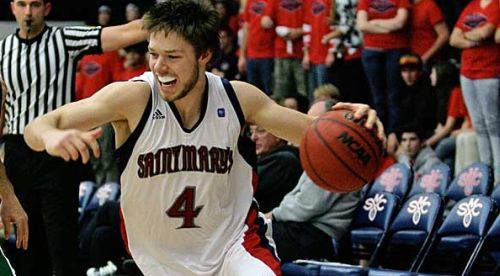
The Gaels Will Once Again Rely Heavily On Standout Guard Matthew Dellavedova (Saint Mary’s athletics)
Hodgson enters a frontcourt rotation of redshirt sophomore Brad Waldow (8.1 PPG, 4.4 RPG in 18.5 minutes), senior Mitchell Young (10.2 PPG, 5.1 RPG in 21.2 minutes as a sophomore, the last time he was healthy) and rejuvenated seven-footer Kyle Rowley. Rowley disappointed last year but rededicated himself to becoming a force in his senior year by dropping 20 pounds of fat and replacing it with muscle. Rowley, who was rounding into shape towards the end of last season, showed his potential in a nine-minute stretch of the Gaels’ nerve-tingling 78-74 overtime win over Gonzaga in the WCC tournament championship game, grabbing six rebounds and scoring a bucket while holding the Zags’ center Robert Sacre scoreless during that time.
Making the frontcourt players better is senior playmaker Dellavedova, who operates Bennett’s pick and roll offense about as well as it can be run. A 2012 finalist for the Bob Cousy award as the nation’s finest point guard, Dellavedova honed his skills as the starting point guard for Australia’s national team in this summer’s Olympics. He will team up with juniors Stephen Holt and Jorden Page in the backcourt, and that group will be strengthened by the addition of James Walker III, who was co-player of the year in the California community college ranks last year. Walker averaged 19.1 PPG and 2.9 APG in leading Citrus College to a 28-2 record and the state JuCo semifinals.
Gonzaga. The preseason hype about Gonzaga is not without merit. The Zags’ outstanding backcourt of Kevin Pangos (13.6 PPG, 3.36 APG) and Gary Bell, Jr. (10.4 PPG, 2.00 APG) should be even better as both players enter their sophomore years, and the Zags return front court stalwarts Elias Harris (13.1 PPG, 8.5 RPG) , Sam Dower (8.3 PPG, 3.7 RPG) and Guy-Landry Edi (5.5 PPG, 2.4 PRG). Also back after a redshirt year following his sophomore season is 7’0″ forward Kelly Olynyk, and new to Spokane is 7’1” freshman Przemek Karnowski of Poland. The Zags have size, depth, experience and firepower, but need Dower to show he can maintain production while playing 30 or more minutes a game instead of the 18.1 MPG he logged as a sophomore.
The Zags’ hopes to dethrone Saint Mary’s revolve around expected improvement from Pangos and Bell in the backcourt and Dower on the front line. Olynyk’s return will provide them depth up front, and Karnowski remains an alluring option. Karnowski dominated tiny Northwest Nazarene (17 pts, 8 rebs in 17 minutes) in the Zags’ only exhibition game, a 93-45 win, and may turn out to be a solid replacement for the departed Robert Sacre. If that is the case, the Gonzaga front court might get crowded.
Returning to bolster Pangos and Bell is reliable playmaker David Stockton, now a redshirt junior, and 6’5” shooting guard Kyle Dranganis from Nampa, ID, who redshirted last year.
BYU. Last year Dave Rose got excellent front court production from the departed Noah Hartsock and Charles Abouo and junior Brandon Davies, but erratic performance from the backcourt, where freshman Matt Carlino sometimes felt he had to do it all. Carlino had an excellent freshman season overall (12.2 PPG, 4.6 APG), but often pressed and took bad shots. He didn’t get much help from junior Craig Cusick or freshman Anson Winder, but all that should change this year with the return of 6’5” Tyler Haws from a two-year Mormon mission, and the enrollment of highly-regarded Cory Calvert from Chaparral High School outside Denver. Another backcourt addition, junior college transfer Raul Delgado from Western Nebraska Community College, dislocated his elbow at the beginning of the academic year and his status is uncertain for the 2012-13 season.
Even though he plays on the wing, Haws should make Carlino’s life immensely easier, and as a result BYU should regain the perimeter scoring attack that has been its trademark. Before leaving on his mission, Haws had one of the best freshman years in BYU history, averaging 11.3 PPG and making a school record 48 straight free throws. Calvert was the Colorado 5A MVP following a season in which he averaged 22.3 PPG, 6.0 RPG and 5.1 APG.
Davies enters the season as the best post man in the conference, following a 15.2 PPG, 7.7 RPG junior season. The question for Rose is, Who will be his Hartsock and Abouo? Leading candidates are 6’11″ sophomore Nate Austin, who was very productive backing up Davies last year, and another JC transfer, 6’8” Agustin Ambrosino from Salt Lake Community College. BYU may have hoped that oft-injured Stephen Rogers was ready to make his senior season one to remember, but as practice started the school decided to shut him down because he had not yet fully recovered from surgery to repair a torn meniscus.
Loyola Marymount. No one feels LMU has a firm hold on fourth place, and the battle to secure that spot behind the Big Three might be one of the intriguing stories of the year. But Max Good’s Lions were the only other team outside the top three to post a winning conference record last year, and boasted road wins over Saint Mary’s (the Gaels’ only home loss of the season) and BYU. Although mainstays Drew Viney, Jarred DuBois and LaRon Armstead are gone, Good’s outstanding point guard, Anthony Ireland (16.1 PPG, 4.94 APG), returns to run the show. Inside veterans Godwin Okonji and Ashley Hamilton (11.0 PPG, 5.6 RPG) are back, as is burly forward C.J. Blackwell (6’5”, 240 lbs.) Blackwell played sparingly behind Viney last year, but managed to average 6.2 PPG and has an excellent outside shooting touch. Those and the erratic Ayodeji Egbeyemi are the heart of the returnees, so who will boost them to keep the Lions in the top half of the league?
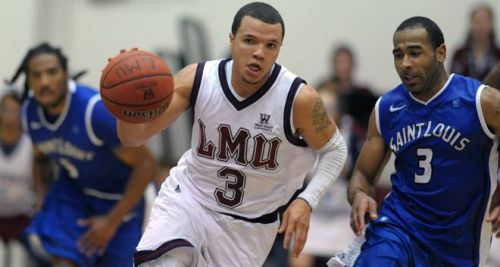
The Play Of Anthony Ireland (middle) Will Be A Huge Factor In Deciding LMU’s Postseason Fate (US Presswire)
Nick Stover, a 6’6” forward from Windward High School in Los Angeles, is the most promising, and should have an opportunity to grab some of Viney’s minutes. He averaged 21.7 PPG and 9.1 RPG to lead Winward to the Division IV state championship game. Also of interest is one-year JC transfer Chase Flint from USU-Eastern, which is what Eastern Utah was called before it formed an association with Utah State University. The 6’1” Flint was a do-everything athlete at Davis High School in Kaysville (outside Ogden), but injured his elbow in the summer after his senior season driving a four-wheeler. He then went on his two-year Mormon mission before enrolling at USU-Eastern, which plays in the tough Scenic West Athletic Conference. He was a star there, making the All-Region Team and being named Eastern’s athlete of the year. Although a sophomore at LMU, Flint is chronologically a senior, so might add some maturity to Good’s occasionally undisciplined crew.
San Diego. It won’t take much improvement for Bill Grier’s Toreros to move from a 7-9 league mark last year to 8-8 this season, and Grier has an experienced squad to move that high or higher. Grier could start the same lineup that finished last year, including his electric backcourt combination of Johnny Dee (13.7 PPG, 42.2 per cent three-point shooting, eight games with 22 or more points) and Christopher Anderson (9/0 PPG, 5.0 APG). Dee and Anderson’s combined production was only slighter less than the ballyhooed Gonzaga combination of Pangos and Bell (22.7 PPG to 24.0 PPG), and Anderson’s assist total was better than either of the Gonzaga backcourt players.
The rest of San Diego’s returning starters are defensive specialist Ken Rancifer at small forward, 6’11” junior forward Dennis Kramer and 6’10”sophomore center Simi Fajemisin. A sixth returnee who saw extensive minutes is senior forward-center Chris Manressa, the team’s top rebounder and third-leading scorer, and still another regular contributor was 6’9” forward John Sinis from Greece. That’s a good group, and Grier had another successful recruiting year to being in some new faces who could help. Mike Davis, a 6’2” guard from Houston, Texas, was a high school star who never found his footing in two years at Texas Tech, and fought injuries in his sophomore season. He spent a year in junior college without playing, and brings experience and size to bolster the smallish Dee and Anderson. Grier continued to cast a wide net, bringing in 6’9” forward Jito Kok of the Netherlands by way of Spain and 6’5” guard Duda Sanadze from Tbilisi, Georgia – not the U.S. version. As with all international players with glossy resumes, it is hard to evaluate Kok and Sanadze until they see action in the U.S. college game, but they add depth to an already deep team.
Santa Clara. Here’s where it gets interesting: figuring where to slot Kerry Keating’s Broncos following an embarrassing 0-16 mark in conference play last season. On paper Santa Clara seems capable of exceeding a 7-9 record and even challenging the top three teams, but winning even seven league games would constitute a remarkable turnaround. The Broncos’ chances revolve around two returning players, senior forward Marc Trasolini, coming off ACL surgery, and junior guard Kevin Foster, the former high-flying three-point bomber who was grounded last year by a DUI charge.
Assuming Trasolini and Foster regain their former status, Keating can join them with a potentially formidable frontcourt of improving 7’0″ sophomore center Robert Garrett, 6’8” senior Niyi Harrison, sophomore Yannick Atanga and junior John McArthur. Add slick point guard Evan Roquemore, who retained his composure during the Broncos’ meltdown last year, and Keating could surprise a lot of teams.
Portland. This is a predicted improvement of only one win over last year’s 3-13 conference mark, but Eric Reveno’s squad has a long way to go to return to the 20-win efficiency of several seasons ago. The problem with the Pilots has been inexperience and a lot of that goes away as players mature. Two of Reveno’s brightest spots, forward Ryan Nicholas (11.5 PPG, 7.6 RPG) and guard Kevin Bailey (9.5 PPG), are a junior and a sophomore, respectively, and that constitutes seniority on this still-young team. To improve, the Pilot big men, 6’10” sophomore Riley Barker and 6’11” sophomore Thomas van der Mars, must step up considerably after respectable freshman campaigns.
Like San Diego, Portland is not afraid to go far abroad for new talent, and the Pilots went all the way to Riga, Latvia to land 6’4” guard Oskars Reinfelds. Closer to home, the Pilots also inked Oregon 5A player of the Year Jake Ehlers, a 6’7” forward who averaged 22 PPG and 7 RPG for Corvalis High School, and Sacramento-Jesuit high school star Bryce Pressley (14.1 PPG, 2.9 APG).
San Francisco. This is quite a comedown for Walters’ Dons, but reflects the hole they have dug by losing so many players from last year. Some of the newcomers look good, including wing man De’End Parker who played briefly for UCLA before returning home to the Bay Area, and Arizona star guard Tim Derksen, but the front court is a work in progress. The only returnee up front is junior forward Cole Dickerson, who averaged 7.1 PPG and 4.0 RPG last year. Walters must rely on instant success from freshmen recruits Matt Christiansen from Oklahoma and Tao Xu, a 6’11” center from China by way of Haverford Prep in Pennsylvania, along with support from JuCo transfer Frank Rogers, to give steady point guard Cody Doolin anyone to pass to inside.
Pepperdine. The Waves won four conference games last year under first-year head coach Marty Wilson, but it is hard to see them repeating that performance given expected improvement from Santa Clara and Portland. The Waves don’t seem to have added much from last year’s squad, and lost three solid contributors in Taylor Darby, Joshua Lowery and Corbin Moore. Sometimes-spectacular guard Jordan Baker returns for his sophomore year, looking to improve on 9.0 PPG average and a four-best-among-freshmen 11.3 PPG in conference. He will be joined by former Wave star Lorne Jackson, who missed last year with a knee injury. Jackson was honorable mention All-WCC in his junior year, averaging 13.2 PPG, and a healthy senior season may be the best tonic for improvement in the Waves’ backcourt.
Up front, the biggest news could be JuCo transfer Malte Kramer, a three-point-shooting forward out of Cuesta College in San Luis Obispo. Kramer averaged 42 per cent on threes in his two years at Cuesta, to fuel a 17.8 PPG average. If 7’ center Jan Maehlen has recovered from multiple injuries in his sophomore year, Kramer and freshman recruit Stacy Davis out of Betty Fairfax High School in Laveen, AZ could provide firepower in the front court.
All-Conference Predictions (last season’s stats in parentheses)
First Team
- G: Matthew Dellavedova, Saint Mary’s (15.5 PPG, 6.4 APG) – Statistics aside, and Dellavedova has a slew of them (all-time assists leader with 545, second all-time in made three-pointers with 202, etc.), his leadership and unerring ability to put the basketball in the right hands at the right time are unmatched in the WCC and probably in the nation.
- G: Anthony Ireland, Loyola Marymount (16.1 PPG, 4.94 APG) –Having led LMU to a 10-game improvement between his freshman year (11-21) and his sophomore year (21-13), Ireland is poised to keep LMU entrenched among the conference’s top teams. An excellent penetrator and three-point shooter, he needs only to become more controlled in running the Lions’ offense to become one of the conference’s all-time great guards.
- F: Elias Harris, Gonzaga (13.1 PPG, 8.5 RPG) – With the graduation of Saint Mary’s Rob Jones, Harris is the pre-eminent power forward in the conference. Hampered by unrealistic professional expectations since his freshman year, he has settled into becoming Gonzaga’s most reliable day-to-day player as a senior.
- F: Brandon Davies, BYU (15.2 PPG, 7.7 RPG) – Davies shared the spotlight with Noah Hartsock last year, but in his senior season will be BYU’s undisputed offensive leader. He is active, imaginative and indefatigable in the paint for the Cougars, providing them with a focus and an inspiration on offense.
- F: Marc Trasolini, Santa Clara (12.8 PPG, 6.1 RPG in 2010-11) – Having missed last season with a torn ACL, Trasolini returns to anchor a Santa Clara team looking for redemption. He can score both inside and outside, is a rugged rebounder and an excellent free-throw shooter.
Sixth Man of the Year
Matt Carlino, BYU (12.2 PPG, 4.6 APG) – Freed from carrying too much of the load in the backcourt for BYU by the return of Tyler Haws, Carlino should emerge as an even more deadly scorer. He can hit the three or go to the hole, and will have a greater opportunity to do both in his sophomore season.
Impact Newcomer
Tyler Haws, BYU (11.3 PPG, 4.2 RPG in 09-10) – Returning from a two-year Mormon mission, Haws hopes to pick up where he left off in his spectacular freshman season for BYU. A deadly three-point shooter, the 6’5” small forward should help restore BYU’s perimeter game, while making Carlino and Davies even more effective.
Reader’s Take II
WCC Tournament Champion/NCAA Automatic Bid Recipient
Saint Mary’s and Gonzaga have feasted on a tournament format that seeds the first and second-place regular season finishers all the way to the semifinals of the conference tournament, guaranteeing no more than two games on the road to a championship. They have faced each other for the championship in each of the last four years, splitting with two wins apiece, and should square off for the title and automatic NCAA bid once again. This will not only be the rubber match in their five-year personal battle, but also the last year for the double-bye, as the conference will change the system with the addition of Pacific in 2013.
Who will win the showdown game? I give the nod to Saint Mary’s, the defending champions, who have waged a dogged battle to supplant Gonzaga as the WCC standard-bearer. Beginning with their rout of the Zags in the 2010 title game, followed up by a split for the regular-season title in 2011 and capped by last year’s outright championship of both the regular-season and tournament titles, the Gaels feel they have earned the conference’s top spot. They have a deep, veteran squad that will defend its title ferociously.
With the automatic bid, Saint Mary’s should receive a seeding no worse than last year’s #7 seed, which pitted them against a beatable foe in Big Ten middle-of-the-pack finisher Purdue. The Gaels punted that opportunity to duplicate their Sweet Sixteen run of 2010, but want to go back and go deeper in 2013. Gonzaga also received a #7 seed last year, and did better with its opportunity than the Gaels, easily topping No. 10 seed West Virginia and battling No. 2 seed Ohio State down to the wire before succumbing 73-66. Based on the Zags’ overall postseason history, they will be in line for a seven or higher seeding this time around.
BYU earned the WCC’s third NCAA bid last year, albeit through a qualifying game in what the NCAA creatively called the First Four Opening Round. It was almost the last four for BYU, however, as it had to stage one of the greatest comebacks in NCAA history to beat the 14th seed Iona Gaels, 78-72. The Cougars fell hard to No. 3 seed Marquette, 88-68, in the next round, so another third place finish in the WCC might put BYU on the bubble.
Additional Postseason Opportunities
The WCC has sent teams to the NIT, CollegeInsider.com and College Basketball Invitational postseason tournaments in recent years (Saint Mary’s to the NIT in 2011, LMU to the CollegeInsider.com and San Francisco to the College Basketball Invitational tourneys in 2012), so the door is certainly open for postseason play beyond the NCAA Tournament. Depending on their overall records, the fourth and even fifth-place finishers could see an opportunity to extend their seasons.
Notable Newcomers
Much attention has been given to Gonzaga’s 7’1” post man, Karnowski, who could anchor the Zags’ middle for years to come. Rating international players is always risky, however, so the jury will remain out until the big Pole bumps head against U.S. college centers. Saint Mary’s has an intriguing newcomer in 6’11” transfer forward Hodgson, but his arrival, too, comes with a question: What about those two less-than-riveting seasons at Southern Utah? Gael fans answer that whatever Hodgson did under tutelage other than Bennett’s shouldn’t count and that the Kevin McHale body double will flourish in the WCC. Other potential breakouts in their initial season include LMU’s Stover and Flint, Pepperdine’s Kramer and Davis, San Francisco’s Parker and Derksen and Portland’s Ehlers.
Continued Improvement
The WCC will expand to 10 teams in the 2013-14 season by welcoming back former league member University of Pacific. The good news is that Pacific was the leading candidate among several schools that are rumored to be interested in joining, including Denver and Seattle. Adding Pacific will smooth out scheduling and travel problems caused by adding BYU as a ninth member last season, and will cement the league’s image as composed of smaller (excluding BYU), faith-based institutions that concentrate on basketball. BYU’s football team competes as an independent like Notre Dame, so its shadow does not hover over the league.
Moreover, by adding teams deliberately, the WCC adds to its reputation as a conference without an identity crisis. This is in contrast to the feverish rush by the power conferences to sacrifice all their identifying characteristics to garner riches through televised football games. Basketball is king in the WCC and the conference is gaining strength annually because of its single-minded dedication to the sport.






























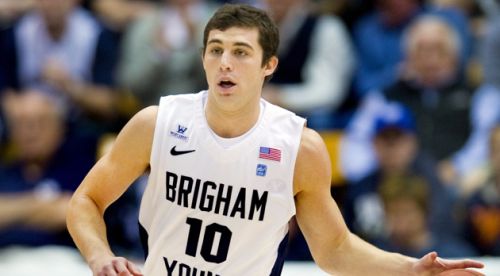
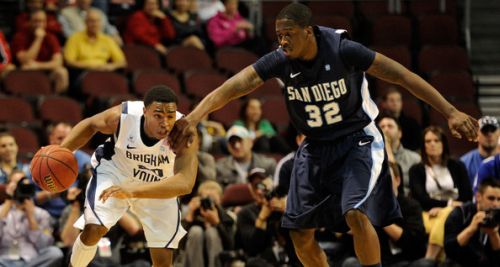
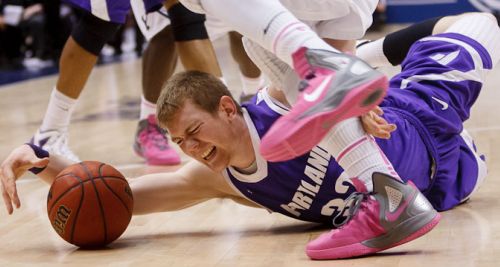

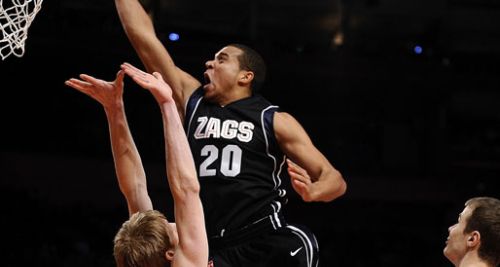













Sounds Like Alameda was hard at work touting myths about St. Mary’s again!!!
“Moreover, by adding teams deliberately, the WCC adds to its reputation as a conference without an identity crisis. This is in contrast to the feverish rush by the power conferences to sacrifice all their identifying characteristics to garner riches through televised football games. Basketball is king in the WCC and the conference is gaining strength annually because of its single-minded dedication to the sport.”
Truer words. I’d say the WCC is a putting on a clinic in responsible and considered brand building.